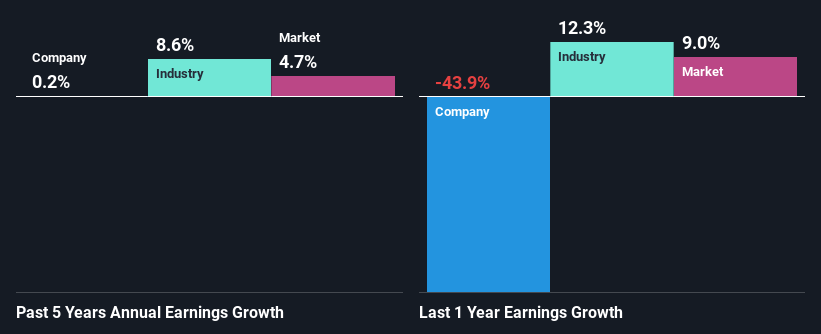Natural Gas Distribution (TADAWUL:9516) has had a rough three months with its share price down 24%. Given that stock prices are usually driven by a company’s fundamentals over the long term, which in this case look pretty weak, we decided to study the company’s key financial indicators. Particularly, we will be paying attention to Natural Gas Distribution’s ROE today.
Return on equity or ROE is an important factor to be considered by a shareholder because it tells them how effectively their capital is being reinvested. In other words, it is a profitability ratio which measures the rate of return on the capital provided by the company’s shareholders.
View our latest analysis for Natural Gas Distribution
How To Calculate Return On Equity?
ROE can be calculated by using the formula:
Return on Equity = Net Profit (from continuing operations) ÷ Shareholders’ Equity
So, based on the above formula, the ROE for Natural Gas Distribution is:
4.4% = ر.س2.5m ÷ ر.س56m (Based on the trailing twelve months to December 2021).
The ‘return’ is the yearly profit. So, this means that for every SAR1 of its shareholder’s investments, the company generates a profit of SAR0.04.
What Has ROE Got To Do With Earnings Growth?
We have already established that ROE serves as an efficient profit-generating gauge for a company’s future earnings. We now need to evaluate how much profit the company reinvests or “retains” for future growth which then gives us an idea about the growth potential of the company. Generally speaking, other things being equal, firms with a high return on equity and profit retention, have a higher growth rate than firms that don’t share these attributes.
A Side By Side comparison of Natural Gas Distribution’s Earnings Growth And 4.4% ROE
As you can see, Natural Gas Distribution’s ROE looks pretty weak. Even when compared to the industry average of 10%, the ROE figure is pretty disappointing. Hence, the flat earnings seen by Natural Gas Distribution over the past five years could probably be the result of it having a lower ROE.
Next, on comparing with the industry net income growth, we found that Natural Gas Distribution’s reported growth was lower than the industry growth of 8.8% in the same period, which is not something we like to see.

The basis for attaching value to a company is, to a great extent, tied to its earnings growth. The investor should try to establish if the expected growth or decline in earnings, whichever the case may be, is priced in. This then helps them determine if the stock is placed for a bright or bleak future. Is Natural Gas Distribution fairly valued compared to other companies? These 3 valuation measures might help you decide.
Is Natural Gas Distribution Efficiently Re-investing Its Profits?
With a high three-year median payout ratio of 95% (implying that the company keeps only 4.5% of its income) of its business to reinvest into its business), most of Natural Gas Distribution’s profits are being paid to shareholders, which explains the absence of growth in earnings.
Summary
In total, we would have a hard think before deciding on any investment action concerning Natural Gas Distribution. The low ROE, combined with the fact that the company is paying out almost if not all, of its profits as dividends, has resulted in the lack or absence of growth in its earnings. Until now, we have only just grazed the surface of the company’s past performance by looking at the company’s fundamentals. To gain further insights into Natural Gas Distribution’s past profit growth, check out this visualization of past earnings, revenue and cash flows.
Have feedback on this article? Concerned about the content? Get in touch with us directly. Alternatively, email editorial-team (at) simplywallst.com.
This article by Simply Wall St is general in nature. We provide commentary based on historical data and analyst forecasts only using an unbiased methodology and our articles are not intended to be financial advice. It does not constitute a recommendation to buy or sell any stock, and does not take account of your objectives, or your financial situation. We aim to bring you long-term focused analysis driven by fundamental data. Note that our analysis may not factor in the latest price-sensitive company announcements or qualitative material. Simply Wall St has no position in any stocks mentioned.


